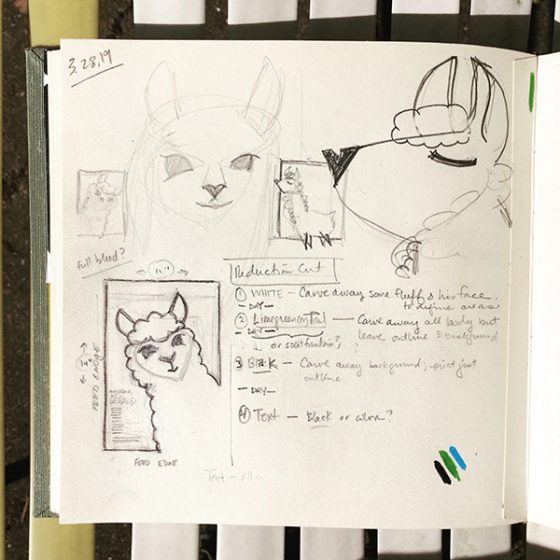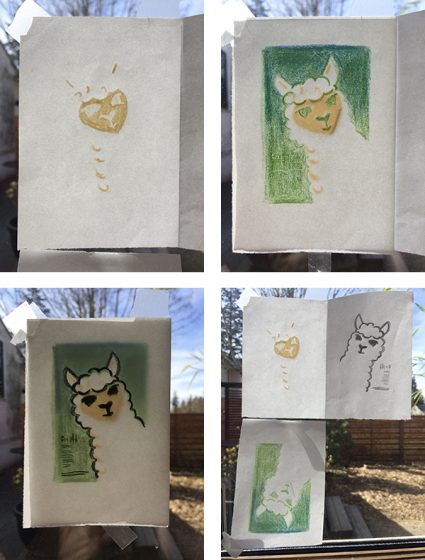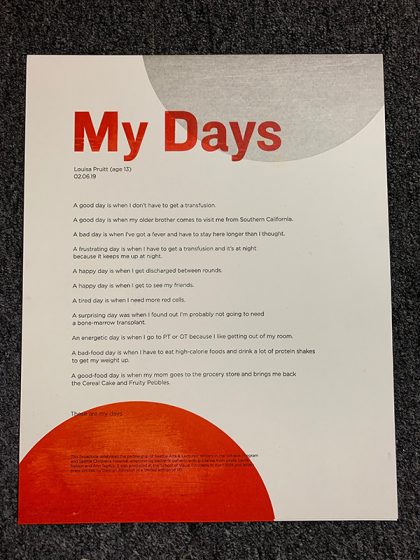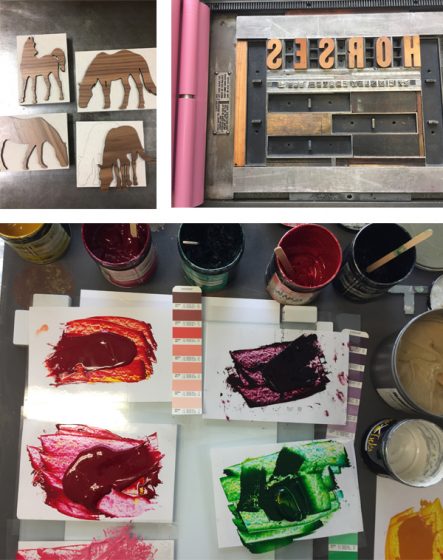In our second installment on the 2020 Seattle Children’s Hospital Broadside / Words of Courage, we shine a spotlight on another trio of printers who breathed life into a family story, brought to life great word pictures, and more.
Their inspiration is the poetry written by children who are patients at the hospital and with the team of Sierra Nelson and Ann Teplick of Seattle’s Writers in the Schools program (WITS).
Heidi Hespelt
I illustrated and printed “The Rat” by Lucy Watters, Age 7, for the Children’s Hospital Broadside poetry project. I think the poem is so fun and I found out after I designed the artwork that it was a family story that was told often in their household.
Lucy, like me, loves animals and has written other poems featuring a variety of species. I wanted this broadside to be something that the family would want to hang on a wall, so the rat became part of the rose bush rather than a grotesque figure. Lucy was in my thoughts the entire time I worked on this piece. I hope that she felt that her poem came to life.
This year was special to me for printing because I set up my own printing shop in January 2020 and the broadside was my first big letterpress project in my own space, using my own machines and newly acquired type. Then Covid hit and put things on hold for so many printers. I felt lucky. I could do the entire project except for cutting the paper. And then, serendipitously, in mid-May a beautiful old paper cutter showed up for sale in Aurora, Oregon. Road trip and the cutter was mine! A couple of days after that, I was able to complete “The Rat” and send early copies to Lucy and her family.
Here is a description of my process:
Here is the mock-up, including hand-set type proof.
Linocut, reduction-style, for the background. I also used pressure printing for the first time ever, to make the rat’s features and roses pink. It felt like an arts and crafts project and I needed some long-distance coaching from my letterpress mentors, Jenny Wilkson and Amy Redmond.
Here I cut away the white parts of the rat and roses, and printed the green background.
More arts and crafts pressure printing to add dimension to the rose bush.
Last pass before printing the type! More of the lino block was cut away so that
the features of the rat and the outlines of the leaves and roses would pop with a darker green.
Here is the final product, before cutting to size.
And one last photo of my new shop, my printer’s helper Sheraton, and of the paper cutter that finished the job so Lucy and her family could receive the prints early.
Annabelle Larner
I was immediately drawn to Peyton Bartz’s poem titled Something New because of the beautiful words about a mermaid tree. I loved Peyton’s descriptions – lumpy, flowing, green, honey-dew melon, rough, scratchy, hard as glass, soft. These words made me think of coral and its magical properties. Everything was hand done but the type was a polymer plate from Boxcar. I found a lovely font, Josefin Slab, to create the poem, which felt contemporary and clean. I knew I wanted to do layers and textures to match the poet’s descriptions, so I forged ahead.
The broadside was created with five separate printing steps on the press:
First pass: I used a piece of wood to create a subtle textured background, and printed it in a warm yellow. Second pass: I drew and cut out the coral-like tree on chipboard, glued it to wood, sealed it with acrylic medium, then printed it in a mossy green. Third pass: I created a mermaid with coral-like qualities to blend in with the tree (and used the same cutout/glued process as the tree), then printed her in blue.
I wanted to give the mermaid more features, so I carved linoleum for her face and tail, and did this fourth pass in light green to match Peyton’s descriptions.
And finally, the fifth and final pass was the poem itself, laying on top of the entire picture so it would stand out. I felt the colors and layers of the elements looked nice and hopefully reflected Peyton’s words!
Sarah Kulfan
This is my seventh year participating in the Seattle Children’s broadside project. I was so happy to join in on its 10th year anniversary! This year, I printed a poem that was written by 16 year old Darren Lagbao, titled ‘My Mom And I’. This poem is a loving tribute to his mom and his words honor her strength, patience and attentiveness, whether she is making adobo with pork sauce and boiled eggs or reading him to sleep.
From an imagery stand point, there is so much in Darren’s poem to inspire. I chose to illustrate the lines where he talks about his mom’s patience in teaching him to care for the family’s 5 dogs. This is something that I have in common as my extended family includes 5 dogs as well.
The image is printed from a reduction cut, or a lino-block that is carved away in between each color layer. I started with a thick paintbrush to paint directly onto the lino-block and then carved around all the little detailed edges to get the dynamic brush strokes in the blue background layer. Then I carved and printed two more layers of brown ink for the mom and the group of dogs.
There is so much in this project to be grateful for, especially this year which was fraught with challenges. I’m grateful to have been able to print Darrens’ words; to work alongside a group of amazingly talented printers; to have so much support in this project from WITS, the School of Visual Concepts (now Partners in Print) and Seattle Children’s Hospital.
Our leadership team is 100% behind this project every year as they guide our team of printers and our sponsor partners encourage us. For more behind-the-scenes, check out Sarah’s blog article about the project here.
Did you miss Part 1 of the 2020 Children’s Broadsides project? Read more and visit Partners in Print to see previous years efforts and news on the 2021 Project. A thousand heartfelt thanks go out to all the printers, young poets & their families, and organizers who continue to make this Broadside collection special every year.












































